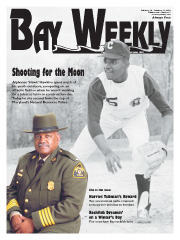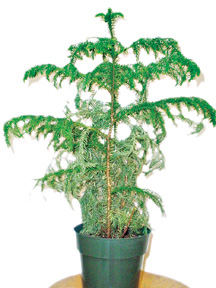Chesapeake Bay's Independent Newspaper ~ Since 1993
1629 Forest Drive, Annapolis, MD 21403 ~ 410-626-9888
Volume xviii, Issue 7 ~ February 18 - February 24, 2010
Home \\ Correspondence \\ from the Editor \\ Submit a Letter \\ Classifieds \\ Contact Us
Best of the Bay \\ Dining Guide \\ Home & Garden Guide \\ Archives \\ Distribution \\ Advertising![]()


This Pine’s No Evergreen
The Bay Gardener
 by Dr. Frank Gouin |
You can raise a forest from Norfolk Island Pine … as long as you winter it inside
I recently received a phone call from a Bay Weekly reader asking me what could have killed the pine trees he planted in his yard last May. They had grown well all summer and appeared to be in good health in the fall. However, before Christmas all of the foliage had turned brown. After the snow from the first snowstorm of the season had melted, he examined the trees closely and discovered that all of the branches were dead, as were the stems.
Since he could not identify the species of pine trees he planted, I suggested that he send me a dead branch.
As soon as I received the sample in the mail, I called to inform him that he had planted Norfolk Island pine, which is not cold hardy. He tried to argue that as it was a pine tree, it should have been able to grow in Southern Maryland.
 Don’t allow the name to fool you. The Norfolk Island pine is not a pine tree at all. It’s an Araucaria, a member of the Araucariacea family, and limited to growing outdoors in tropical regions. Its landscape use is limited to southern Florida, the southern tip of Texas and the lower Pacific coast of California. It is not related to pine trees other than being a conifer. It is commonly grown in containers as a house plant here in the East.
Don’t allow the name to fool you. The Norfolk Island pine is not a pine tree at all. It’s an Araucaria, a member of the Araucariacea family, and limited to growing outdoors in tropical regions. Its landscape use is limited to southern Florida, the southern tip of Texas and the lower Pacific coast of California. It is not related to pine trees other than being a conifer. It is commonly grown in containers as a house plant here in the East.
If you’ve taken your Norfolk Island pines indoors, you might try to propagate it from cuttings. If you root cuttings taken from the branches, the resulting plants will be shrub-like and never develop an upright habit of growth. Only cuttings taken from the terminal will produce upright-growing plants. Thus, commercial propagators of Norfolk Island pine encourage multiple stems to develop on young plants by removing the terminal buds. Every time you remove the terminal bud, two stems develop from the cut area. To be economically feasible, propagators force each plant to develop a dozen or more stems by taking tip cuttings frequently or by pinching the terminal bud.
Learn from the Bay Gardener
Fruits and vegetables you can grow in your garden discussed by the Bay Gardener in Chesapeake Railway Museum’s Bayside Chat at 2pm March 7 at Northeast Community Center, Chesapeake Beach. Free: 410-257-2554.
Ask Dr. Gouin your questions at [email protected]. All questions will appear in Bay Weekly. Please include your name and address.
© COPYRIGHT 2010 by New Bay Enterprises, Inc. All rights reserved.